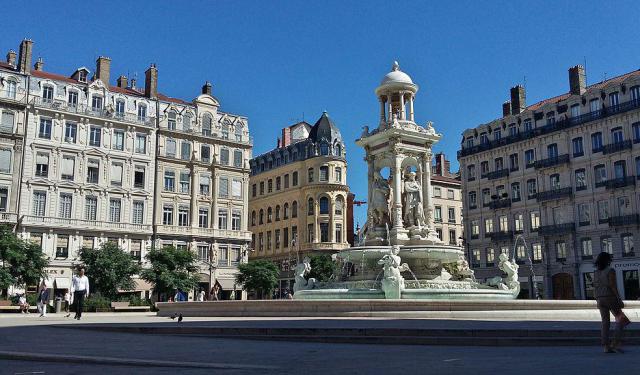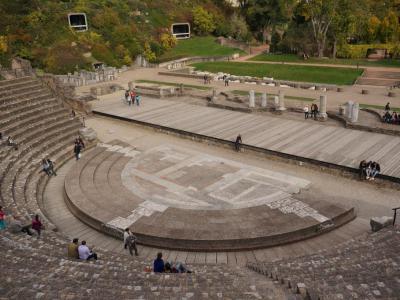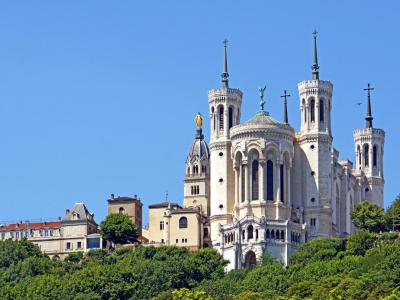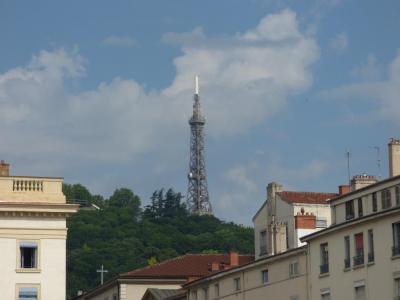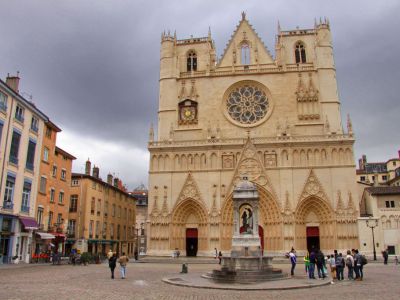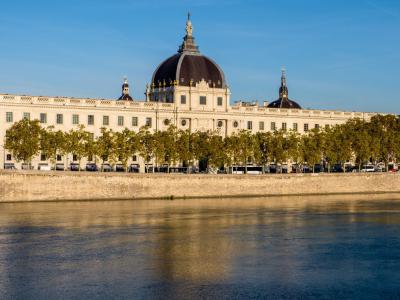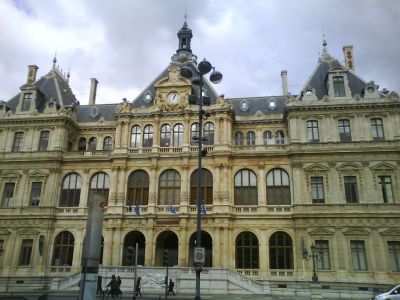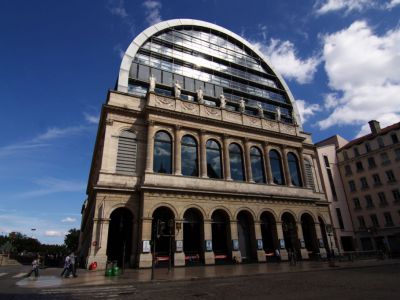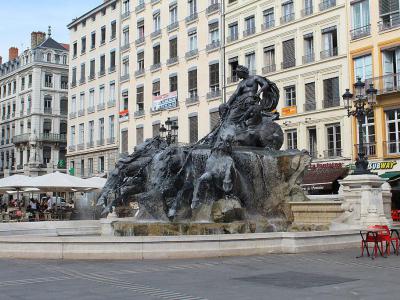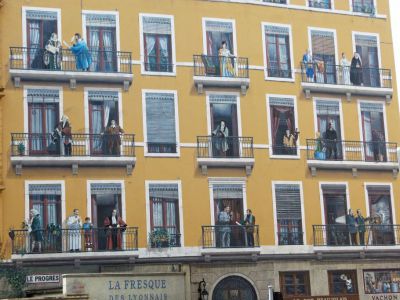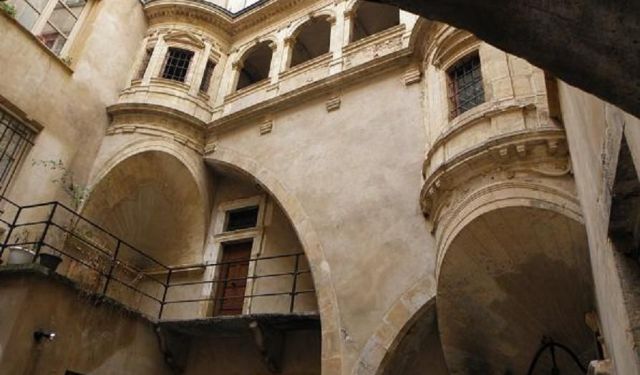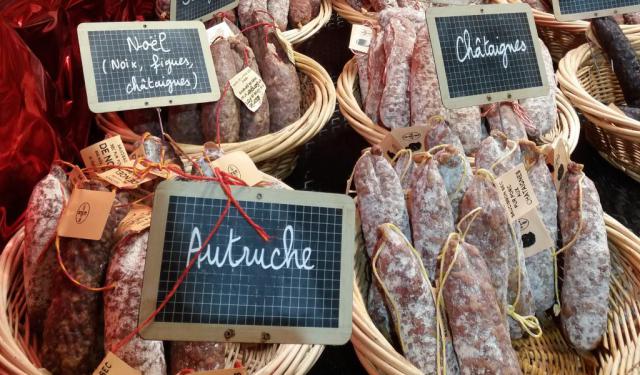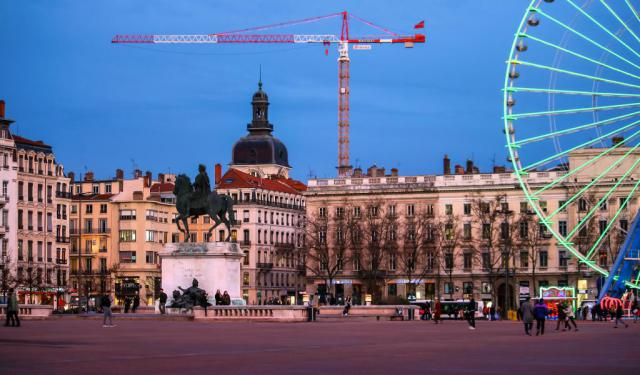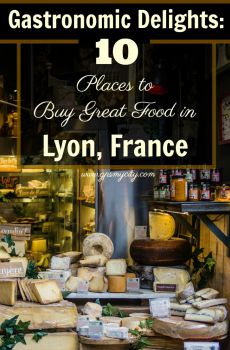Lyon's Architectural Landmarks (Self Guided), Lyon
Founded by the Romans in the 1st century BC, the charming French city of Lyon has played a major role in the political, cultural, and economic development of Europe for many years. The city's two millennia-long history is clearly imprinted in its urban fabric, manifested in numerous buildings of various epochs and styles.
Among the plethora of local architectural landmarks, the Ancient Theatre of Fourvière, or Amphitheatre Gallo-Romain, stands as a testament to the Roman influence in the region. Dating back to 19 AD, it once hosted grand performances and still captivates visitors with its well-preserved ruins.
Overlooking Lyon, the Basilica of Notre-Dame de Fourvière reigns supreme. This stunning basilica, built in the 19th century, combines Romanesque and Byzantine styles, making it a striking symbol of both faith and architecture. Nearby, the Metallic Tower of Fourvière adds a modern touch to the skyline, offering panoramic views of the city.
Lyon Cathedral, a masterpiece of Gothic architecture, showcases intricate details and stunning stained glass windows. Meanwhile, Hotel Dieu, a historic hospital turned luxury hotel, boasts impressive courtyards and architecture.
The Palais du Commerce, Lyon's former stock exchange, is an exquisite example of Neo-Renaissance design. It now serves as the Chamber of Commerce and Industry. For lovers of the performing arts, Lyon Opera House is a must-see. Its Neoclassical façade hides opulent interiors where world-class operas and ballets come to life.
The Bartholdi Fountain, sculpted by Frédéric Auguste Bartholdi of Statue of Liberty fame, adorns the Place des Terreaux with its artistic grandeur. And, don't forget the Fresque des Lyonnais, a massive mural celebrating Lyon's notable figures throughout history, which graces a city wall.
We thus encourage you to explore Lyon's remarkable architectural treasures firsthand, for visiting these locations not only deepens one's appreciation for Lyon's heritage but also promises unforgettable experiences. Regardless of your prime interests in travel, be it architecture, history, or simply a quest for a picturesque adventure, Lyon's architectural gems will undoubtedly leave you awe-inspired!
Among the plethora of local architectural landmarks, the Ancient Theatre of Fourvière, or Amphitheatre Gallo-Romain, stands as a testament to the Roman influence in the region. Dating back to 19 AD, it once hosted grand performances and still captivates visitors with its well-preserved ruins.
Overlooking Lyon, the Basilica of Notre-Dame de Fourvière reigns supreme. This stunning basilica, built in the 19th century, combines Romanesque and Byzantine styles, making it a striking symbol of both faith and architecture. Nearby, the Metallic Tower of Fourvière adds a modern touch to the skyline, offering panoramic views of the city.
Lyon Cathedral, a masterpiece of Gothic architecture, showcases intricate details and stunning stained glass windows. Meanwhile, Hotel Dieu, a historic hospital turned luxury hotel, boasts impressive courtyards and architecture.
The Palais du Commerce, Lyon's former stock exchange, is an exquisite example of Neo-Renaissance design. It now serves as the Chamber of Commerce and Industry. For lovers of the performing arts, Lyon Opera House is a must-see. Its Neoclassical façade hides opulent interiors where world-class operas and ballets come to life.
The Bartholdi Fountain, sculpted by Frédéric Auguste Bartholdi of Statue of Liberty fame, adorns the Place des Terreaux with its artistic grandeur. And, don't forget the Fresque des Lyonnais, a massive mural celebrating Lyon's notable figures throughout history, which graces a city wall.
We thus encourage you to explore Lyon's remarkable architectural treasures firsthand, for visiting these locations not only deepens one's appreciation for Lyon's heritage but also promises unforgettable experiences. Regardless of your prime interests in travel, be it architecture, history, or simply a quest for a picturesque adventure, Lyon's architectural gems will undoubtedly leave you awe-inspired!
How it works: Download the app "GPSmyCity: Walks in 1K+ Cities" from Apple App Store or Google Play Store to your mobile phone or tablet. The app turns your mobile device into a personal tour guide and its built-in GPS navigation functions guide you from one tour stop to next. The app works offline, so no data plan is needed when traveling abroad.
Lyon's Architectural Landmarks Map
Guide Name: Lyon's Architectural Landmarks
Guide Location: France » Lyon (See other walking tours in Lyon)
Guide Type: Self-guided Walking Tour (Sightseeing)
# of Attractions: 9
Tour Duration: 2 Hour(s)
Travel Distance: 4.3 Km or 2.7 Miles
Author: jenny
Sight(s) Featured in This Guide:
Guide Location: France » Lyon (See other walking tours in Lyon)
Guide Type: Self-guided Walking Tour (Sightseeing)
# of Attractions: 9
Tour Duration: 2 Hour(s)
Travel Distance: 4.3 Km or 2.7 Miles
Author: jenny
Sight(s) Featured in This Guide:
- Ancient Theatre of Fourvière (Amphitheatre Gallo-Romain)
- Basilica of Notre-Dame de Fourvière
- Metallic Tower of Fourviere
- Lyon Cathedral
- Hôtel Dieu
- Palais du Commerce (Chamber of Commerce)
- Lyon Opera House
- Bartholdi Fountain
- Fresque des Lyonnais (The Lyon Fresco)
1) Ancient Theatre of Fourvière (Amphitheatre Gallo-Romain) (must see)
There are a lot of interesting vestiges of ancient Lyon to behold and one of the best of them, undoubtedly, is the Amphitheatre Gallo-Romain, at the foot of the Croix-Rousse Hill.
This theatre, first built under the reign of Roman Emperor Tiberius, around 19AD, was also known as the Amphitheatre des Trois Gaules. Its main purpose was to serve as the Sanctuary of the Three Gauls – an administrative institution set to federalize and romanize Gallia as an Imperial province.
Other than that, the theatre was used, as were all such places in Roman times, as a place for entertainment. Theatrical plays were put on here along with gladiator fights and other public events. The theatre was also used for public executions.
The original amphitheatre wasn’t very large; it had room for just about 1,800 spectators. The basement was made up of three elliptical walls joined by cross-walls and a channel around the oval central space.
Around 230 AD the theatre was enlarged, added with two new galleries, which brought the seating space up to 20,000. At the end of the Gallo-Roman era the theatre was abandoned and fell into ruin, with parts of it being built on.
Archaeological digs between 1956 and 1976 uncovered the remains of what you can see today in the Jardin des Plantes.
This theatre, first built under the reign of Roman Emperor Tiberius, around 19AD, was also known as the Amphitheatre des Trois Gaules. Its main purpose was to serve as the Sanctuary of the Three Gauls – an administrative institution set to federalize and romanize Gallia as an Imperial province.
Other than that, the theatre was used, as were all such places in Roman times, as a place for entertainment. Theatrical plays were put on here along with gladiator fights and other public events. The theatre was also used for public executions.
The original amphitheatre wasn’t very large; it had room for just about 1,800 spectators. The basement was made up of three elliptical walls joined by cross-walls and a channel around the oval central space.
Around 230 AD the theatre was enlarged, added with two new galleries, which brought the seating space up to 20,000. At the end of the Gallo-Roman era the theatre was abandoned and fell into ruin, with parts of it being built on.
Archaeological digs between 1956 and 1976 uncovered the remains of what you can see today in the Jardin des Plantes.
2) Basilica of Notre-Dame de Fourvière (must see)
"Fourviere" is a corruption of the French version of the Latin name, "forum vetus," meaning "Old Forum." Old Forum in French becomes "Vieux-Forum." Reverse it and say it fast and voila! We have "Fourviere." The Basilica of Notre-Dame de Fourviere of Lyon is sitting on the remains the Roman forum built by Trajan. Nothing more need be said.
The basilica was built in the years 1872 to 1896 using private funds. The church is dedicated to the Virgin Mary. She is credited with saving the city from the Black Plague in 1643. Each December 8th, the Festival of Lights is held in her honor. Lighted candles are placed outside every window, and Light Shows play over building facades.
The Virgin has not been neglectful. It is said she also saved the city from the Cholera epidemic in 1832 and the Prussian invasion of 1871. Like the Sacred Heart of Montmartre (Sacré Coeur de Montmartre), the Basilica of Notre-Dame de Fourviere perches on a high hill, a votive offering and a victory memorial.
The basilica has a Museum of Sacred Art and sees over two million visitors and pilgrims every year. The church was designed by historicist architect Pierre Bossan. He foreswore Gothic influences, embracing Romanesque and Byzantine styles.
The basilica has four towers and a bell tower with a gilded statue of the Virgin. There is a wealth of mosaics, stained glass and a crypt to Saint Joseph. There are actually two sanctuaries. The upper one is lush and ornate. The lower sanctuary is simple. The building, with its four towers, is said to look like an elephant upside-down.
The basilica is not the first shrine at Fourviere. The earliest chapel on the site dedicated to Mary dates from 1170. The most recent reconstruction was in 1852 when the tower bearing the golden statue by sculptor Joseph Fabisch was installed. The city committed to build the basilica after the Franco-Prussian War of 1871.
The basilica was built in the years 1872 to 1896 using private funds. The church is dedicated to the Virgin Mary. She is credited with saving the city from the Black Plague in 1643. Each December 8th, the Festival of Lights is held in her honor. Lighted candles are placed outside every window, and Light Shows play over building facades.
The Virgin has not been neglectful. It is said she also saved the city from the Cholera epidemic in 1832 and the Prussian invasion of 1871. Like the Sacred Heart of Montmartre (Sacré Coeur de Montmartre), the Basilica of Notre-Dame de Fourviere perches on a high hill, a votive offering and a victory memorial.
The basilica has a Museum of Sacred Art and sees over two million visitors and pilgrims every year. The church was designed by historicist architect Pierre Bossan. He foreswore Gothic influences, embracing Romanesque and Byzantine styles.
The basilica has four towers and a bell tower with a gilded statue of the Virgin. There is a wealth of mosaics, stained glass and a crypt to Saint Joseph. There are actually two sanctuaries. The upper one is lush and ornate. The lower sanctuary is simple. The building, with its four towers, is said to look like an elephant upside-down.
The basilica is not the first shrine at Fourviere. The earliest chapel on the site dedicated to Mary dates from 1170. The most recent reconstruction was in 1852 when the tower bearing the golden statue by sculptor Joseph Fabisch was installed. The city committed to build the basilica after the Franco-Prussian War of 1871.
3) Metallic Tower of Fourviere
The Metallic Tower of Fourviere is a true landmark of Lyon, bearing striking resemblance to the Eiffel Tower in Paris which was built three years earlier. Some of the locals refer to it as the “Eiffel Tower” or the “Picon”; a fairly widespread rumor attributes its paternity to Gustave Eiffel, although no kinship has been proven.
The steel framework structure stands 85.9 metres high and weights 210 tons. Atop the Fourvière hill it marks the highest point in Lyon, culminating at an altitude of 372 metres. The tower opened to the public for the first time on May 3, 1894.
Originally, it had a restaurant on the ground floor, and a Roux-Combaluzier lift capable of carrying 22 people to the summit observatory, 80 metres high, for a fee of 1 franc. The latter was particularly popular during the Exposition Universelle of 1914 held in Lyon.
In 1905, the Gay family – the then owners of the land on which it stands – acquired the tower and kept it in their possession for nearly 40 years, using it as an observation facility, complete with restaurant and souvenir shop.
At some point, the commercial affairs came into decline and, in 1943, the tower was dangerously close to being destroyed for scrap metal. Luckily, the ensued legal fight managed to repeal the already issued requisition order and the tower was saved. In 1953, it was bought by the French Radio-Television (RTF) company, which sought an elevated point for broadcasting the only channel of the local TV station inaugurated a year later.
In 1963, the tower became a relay antenna for RTF, and has since been no longer open to the public. Its decoration at the base has given way to concrete, the upper terrace has been removed, and the original hydraulic piston elevator replaced with an electric model carrying 4 passengers only.
The steel framework structure stands 85.9 metres high and weights 210 tons. Atop the Fourvière hill it marks the highest point in Lyon, culminating at an altitude of 372 metres. The tower opened to the public for the first time on May 3, 1894.
Originally, it had a restaurant on the ground floor, and a Roux-Combaluzier lift capable of carrying 22 people to the summit observatory, 80 metres high, for a fee of 1 franc. The latter was particularly popular during the Exposition Universelle of 1914 held in Lyon.
In 1905, the Gay family – the then owners of the land on which it stands – acquired the tower and kept it in their possession for nearly 40 years, using it as an observation facility, complete with restaurant and souvenir shop.
At some point, the commercial affairs came into decline and, in 1943, the tower was dangerously close to being destroyed for scrap metal. Luckily, the ensued legal fight managed to repeal the already issued requisition order and the tower was saved. In 1953, it was bought by the French Radio-Television (RTF) company, which sought an elevated point for broadcasting the only channel of the local TV station inaugurated a year later.
In 1963, the tower became a relay antenna for RTF, and has since been no longer open to the public. Its decoration at the base has given way to concrete, the upper terrace has been removed, and the original hydraulic piston elevator replaced with an electric model carrying 4 passengers only.
4) Lyon Cathedral (must see)
In 450 AD, on or about, Patiens, sainted Bishop of Lyon, had a cathedral built in Lyon named for Saint Stephen. In the seventh century a baptistry was constructed as an adjunct to the cathedral. The Church of Saint Croix was nearby. This area, in the heart of Old Lyon, near the River Saone, became the site of Lyon Cathedral in 1180.
Built on the ruins of Saint Stephen's, the cathedral was founded by Saints Pothinus and Irenaeus. Construction begun in 1180 and completed in 1476. The architectural style is a harmonious blend of Gothic and Romanesque. The blend of styles is consistent, untrammeled by the over-long period of construction.
The building is 263 feet long and 66 feet wide at the choir. The nave is 107 feet high. The facade is moderately Gothic, featuring high pointed arches and pediments. The apse and choir are Romanesque. The high ribbed vault of the nave is Gothic.
Inside the cathedral is a 30-foot high astronomical clock. An astrolabe cites dates and locations of the stars, Moon, Sun and Earth. The clock was first installed in 1383. Destroyed in a raid by Francois de Beaument, the Baron of Adrets, in the War of Religions in 1562, it was rebuilt by master clockmaker Guillaume Norrisson in 1661.
Each December, in honor of the Virgin Mary, lighted candles are placed outside the windows of Lyon. The facade of the cathedral comes alive with a stunning multicolored light show. The festival marks the miraculous end of the plague in Lyons in 1643.
Built on the ruins of Saint Stephen's, the cathedral was founded by Saints Pothinus and Irenaeus. Construction begun in 1180 and completed in 1476. The architectural style is a harmonious blend of Gothic and Romanesque. The blend of styles is consistent, untrammeled by the over-long period of construction.
The building is 263 feet long and 66 feet wide at the choir. The nave is 107 feet high. The facade is moderately Gothic, featuring high pointed arches and pediments. The apse and choir are Romanesque. The high ribbed vault of the nave is Gothic.
Inside the cathedral is a 30-foot high astronomical clock. An astrolabe cites dates and locations of the stars, Moon, Sun and Earth. The clock was first installed in 1383. Destroyed in a raid by Francois de Beaument, the Baron of Adrets, in the War of Religions in 1562, it was rebuilt by master clockmaker Guillaume Norrisson in 1661.
Each December, in honor of the Virgin Mary, lighted candles are placed outside the windows of Lyon. The facade of the cathedral comes alive with a stunning multicolored light show. The festival marks the miraculous end of the plague in Lyons in 1643.
5) Hôtel Dieu
The opulent Hôtel-Dieu de Lyon is the former hospital on the bank of the Rhône in Lyon; it is one of the largest buildings of the Presqu’île peninsula.
Back in the year 1000, the Ordre des Frères Pontifes (Bridge-Building Brotherhood) established here a minimal care facility for ailing pilgrims. In 1184 it became a hospital, known as the Hopîtal du Pont du Rhône, run by nuns. Initially, it was quite small, with only a priory and a chapel.
The first qualified doctor appeared there in 1454. In 1478 the municipality bought the facility and enlarged it to 200 beds, simultaneously adding a new chapel and a cemetery. During the 15th century, it was enlarged again, with the chapel turned into wards. In 1622 the outbuildings were pulled down and replaced with a number of buildings in the form of a cross around a central dome. Soon, a new church was built, designed by Guillaume Ducellet, followed by yet another building for convalescents added in 1663.
In 1761, Jacques-Germain Soufflot built the Grand Dome for changing the air over the large wards down below. During the French Revolution, all the unqualified workers were dismissed and replaced with trained medical personnel.
The hospital was enlarged once again in the early 19th century. In 1896, the first radiology department in France, performing X-rays, was established. In 1923 an Oncology department was set up in the Grand Dome.
The institution continued operating as a CHU (Centre Hospitalier Universitaire) – a teaching hospital – until its closure in 2010. As of 2019 the complex has been converted into a luxury hotel and a shopping mall.
Back in the year 1000, the Ordre des Frères Pontifes (Bridge-Building Brotherhood) established here a minimal care facility for ailing pilgrims. In 1184 it became a hospital, known as the Hopîtal du Pont du Rhône, run by nuns. Initially, it was quite small, with only a priory and a chapel.
The first qualified doctor appeared there in 1454. In 1478 the municipality bought the facility and enlarged it to 200 beds, simultaneously adding a new chapel and a cemetery. During the 15th century, it was enlarged again, with the chapel turned into wards. In 1622 the outbuildings were pulled down and replaced with a number of buildings in the form of a cross around a central dome. Soon, a new church was built, designed by Guillaume Ducellet, followed by yet another building for convalescents added in 1663.
In 1761, Jacques-Germain Soufflot built the Grand Dome for changing the air over the large wards down below. During the French Revolution, all the unqualified workers were dismissed and replaced with trained medical personnel.
The hospital was enlarged once again in the early 19th century. In 1896, the first radiology department in France, performing X-rays, was established. In 1923 an Oncology department was set up in the Grand Dome.
The institution continued operating as a CHU (Centre Hospitalier Universitaire) – a teaching hospital – until its closure in 2010. As of 2019 the complex has been converted into a luxury hotel and a shopping mall.
6) Palais du Commerce (Chamber of Commerce)
The headquarters of Lyon's Chamber of Commerce and Industry, Palais de Commerce was initially intended to house a museum of art and industry together with shops and offices for silk trade, as well as the Chamber of Commerce and Tribunal.
The decision to build the palace was taken by the City Council in 1853. The project was finished in 1860, designed by architect René Dardel, featuring four pavilions around a central glass-roofed main hall, called the “Salle de la Corbeille”, with both the north and south façades richly decorated with ornate coping and columns supporting elegant balconies.
The statues representing Agriculture, Industry, Justice, Temperance and Trade reflect the purpose of the work carried out inside the building. The ceiling paintings done by Lyonnais artists, such as Ponthus-Cinier and Beuchot, continue the themes of the statues.
At the foot of the steps giving onto Place des Cordeliers there are two more, allegorical statues depicting the Rivers Saône and Rhône with their arms entwined. On the north side of the building, the former Place de la Bourse has been turned into a small, rather charming public garden.
In 1894, President of the Third Republic, Sadi Carnot, was assassinated while leaving the building. In memory of the late president, there is a plaque installed on the wall near the main entrance.
Parts of the palace are open to the public for guided tours only.
The decision to build the palace was taken by the City Council in 1853. The project was finished in 1860, designed by architect René Dardel, featuring four pavilions around a central glass-roofed main hall, called the “Salle de la Corbeille”, with both the north and south façades richly decorated with ornate coping and columns supporting elegant balconies.
The statues representing Agriculture, Industry, Justice, Temperance and Trade reflect the purpose of the work carried out inside the building. The ceiling paintings done by Lyonnais artists, such as Ponthus-Cinier and Beuchot, continue the themes of the statues.
At the foot of the steps giving onto Place des Cordeliers there are two more, allegorical statues depicting the Rivers Saône and Rhône with their arms entwined. On the north side of the building, the former Place de la Bourse has been turned into a small, rather charming public garden.
In 1894, President of the Third Republic, Sadi Carnot, was assassinated while leaving the building. In memory of the late president, there is a plaque installed on the wall near the main entrance.
Parts of the palace are open to the public for guided tours only.
7) Lyon Opera House
A successful amalgamation of the old and new, the Lyon Opera House is in fact the third incarnation of an opera house on this site.
The original one was built in 1756, designed by Jacques-Germain Soufflot. By 1826 the building had proven too small and had to be pulled down. Another, larger theater, featuring Neo-Classical style, was built in its place in 1830 by architects Pollet and Chenavard.
That edifice, in turn, was also considered small and outdated in the mid 20th century, upon which a competition was launched to build a renovated and enlarged version. The competition was won by Jean Nouvel in 1986.
Nouvel kept only the façade and made more space by having basement areas dug out for rehearsal rooms. On top of the building, above the statues of the Muses, he added a steel-and-glass cylinder that is seen today. This allowed to hide the rather ugly fly tower and is now mostly used by the ballet. The magnificent lobby retained the original stucco work, gilts and frescoes, tall arched windows and several lovely chandeliers. The main auditorium is oval shaped and has six levels of galleries.
If you consider taking in a play, opera or ballet, whilst in Lyon, don’t hesitate to book your tickets here. There are wonderful views of the city to be enjoyed from the dome’s terrace too.
The original one was built in 1756, designed by Jacques-Germain Soufflot. By 1826 the building had proven too small and had to be pulled down. Another, larger theater, featuring Neo-Classical style, was built in its place in 1830 by architects Pollet and Chenavard.
That edifice, in turn, was also considered small and outdated in the mid 20th century, upon which a competition was launched to build a renovated and enlarged version. The competition was won by Jean Nouvel in 1986.
Nouvel kept only the façade and made more space by having basement areas dug out for rehearsal rooms. On top of the building, above the statues of the Muses, he added a steel-and-glass cylinder that is seen today. This allowed to hide the rather ugly fly tower and is now mostly used by the ballet. The magnificent lobby retained the original stucco work, gilts and frescoes, tall arched windows and several lovely chandeliers. The main auditorium is oval shaped and has six levels of galleries.
If you consider taking in a play, opera or ballet, whilst in Lyon, don’t hesitate to book your tickets here. There are wonderful views of the city to be enjoyed from the dome’s terrace too.
8) Bartholdi Fountain
While every town or city in France is proud of its fountains, Lyon justifiably takes pride in its most famous one – Bartholdi Fountain – on Place des Terreaux.
The fountain was designed by Frédéric Auguste Bartholdi in 1889 and manufactured by Gaget and Gautier. It was originally intended for the city of Bordeaux when first exhibited at the Exposition Universelle of 1889. After the show, however, the mayor of Bordeaux perceived it too expensive for his city, and so the fountain was bought by the mayor of Lyon in 1890.
The centerpiece of the fountain is an allegorical sculpture of the River Garonne, called the “Char triumphant de la Garonne”, featuring a woman with a small child in a chariot drawn by four water horses. The statue is made of lead on an iron frame; it weighs 21 tons and is 4.85 meters high.
The woman figure represents the Garonne and the four horses with their bridles of water weeds represent its four main tributaries, namely: the Tarn, Ariège, Lot and Gers. The horses are leaping and plunging, thus symbolizing these tributaries jumping into the sea. However, since placed in Lyon, the woman figure is believed to be representing the River Saône instead.
Architect Bartholdi is best known for his other major works, like the Lion of Belfort created in 1879 and the Statue of Liberty in 1886.
The fountain was designed by Frédéric Auguste Bartholdi in 1889 and manufactured by Gaget and Gautier. It was originally intended for the city of Bordeaux when first exhibited at the Exposition Universelle of 1889. After the show, however, the mayor of Bordeaux perceived it too expensive for his city, and so the fountain was bought by the mayor of Lyon in 1890.
The centerpiece of the fountain is an allegorical sculpture of the River Garonne, called the “Char triumphant de la Garonne”, featuring a woman with a small child in a chariot drawn by four water horses. The statue is made of lead on an iron frame; it weighs 21 tons and is 4.85 meters high.
The woman figure represents the Garonne and the four horses with their bridles of water weeds represent its four main tributaries, namely: the Tarn, Ariège, Lot and Gers. The horses are leaping and plunging, thus symbolizing these tributaries jumping into the sea. However, since placed in Lyon, the woman figure is believed to be representing the River Saône instead.
Architect Bartholdi is best known for his other major works, like the Lion of Belfort created in 1879 and the Statue of Liberty in 1886.
9) Fresque des Lyonnais (The Lyon Fresco) (must see)
On the Saone side of the first arrondissement, on the corner of Quai Saint Vincent and Martinière Street, stands a seven-story building. Two of the walls of the building, one measuring 800 square meters and the other 200 square meters, are covered with a massive "trompe-l'oeil," a mural called a "trick of the eye."
There are 200 meters of mural on the Saint Vincent side and 600 on the side of Martinière. The building has become a popular historical monument for visitors, showing 24 historic and six modern-day persons who have made the city what it is. The modern personalities are shown at street level "interacting" with passersby.
The massive fresco spans 2,000 years of Lyonnais history, from Emperor Claudius of Ancient Rome to L'abbe Pierre, founder of the anti-poverty movement Emmaus and French Resistance fighter, and Bernard Lacombe, who had scored 255 goals in football by 1987. Paul Bocuse, Michelin star master chef, stands in the doorway of an illusionary cafe.
Giovanni de Verrazzo is there. While in the service of Francois I, he discovered New York City before it was anything. Antoine de Saint Exupery and his Little Prince share a balcony. Edouard Herriot, mayor of Lyon for 50 years, smokes his pipe. Auguste and Louis Lumiere show their "cinematograph" the first motion-picture camera.
Many more figures are looking out of windows and taking to their balconies for the open air. The mural was created in 1995 by the artist cooperative, CiteCreation. The object was the revitalization of this heavily trafficked waterfront district. CiteCreation created a similar "balcony" mural in Barcelona, Spain.
The best time to study the mural is early on a sunny day. The light is best between 10 and 11 am. The neighborhood is filled with wall paintings. Of course, none are on the level with The Lyon Fresco.
There are 200 meters of mural on the Saint Vincent side and 600 on the side of Martinière. The building has become a popular historical monument for visitors, showing 24 historic and six modern-day persons who have made the city what it is. The modern personalities are shown at street level "interacting" with passersby.
The massive fresco spans 2,000 years of Lyonnais history, from Emperor Claudius of Ancient Rome to L'abbe Pierre, founder of the anti-poverty movement Emmaus and French Resistance fighter, and Bernard Lacombe, who had scored 255 goals in football by 1987. Paul Bocuse, Michelin star master chef, stands in the doorway of an illusionary cafe.
Giovanni de Verrazzo is there. While in the service of Francois I, he discovered New York City before it was anything. Antoine de Saint Exupery and his Little Prince share a balcony. Edouard Herriot, mayor of Lyon for 50 years, smokes his pipe. Auguste and Louis Lumiere show their "cinematograph" the first motion-picture camera.
Many more figures are looking out of windows and taking to their balconies for the open air. The mural was created in 1995 by the artist cooperative, CiteCreation. The object was the revitalization of this heavily trafficked waterfront district. CiteCreation created a similar "balcony" mural in Barcelona, Spain.
The best time to study the mural is early on a sunny day. The light is best between 10 and 11 am. The neighborhood is filled with wall paintings. Of course, none are on the level with The Lyon Fresco.
Walking Tours in Lyon, France
Create Your Own Walk in Lyon
Creating your own self-guided walk in Lyon is easy and fun. Choose the city attractions that you want to see and a walk route map will be created just for you. You can even set your hotel as the start point of the walk.
Lyon Secret Passageways Walk
Lyon’s secret passageways, known as traboules, form a hidden network of covered corridors that wind through courtyards, staircases, and buildings, revealing a colourful and little-seen side of the city’s past. The name comes from the Latin trans-ambulare, meaning “to pass through,” and their origins date as far back as the 4th century, when the inhabitants of Lugdunum (ancient Lyon) used... view more
Tour Duration: 1 Hour(s)
Travel Distance: 1.8 Km or 1.1 Miles
Tour Duration: 1 Hour(s)
Travel Distance: 1.8 Km or 1.1 Miles
Food Tour in Lyon
In addition to its architectural beauty, Lyon – often referred to as the gastronomic capital of France – boasts a vibrant culinary scene that will delight passionate foodies. An ideal place to discover French cuisine and fall in love with it, there is no shortage of addresses in Lyon to stock up on quality and delicious products.
At the heart of Lyon's culinary culture is the Paul... view more
Tour Duration: 1 Hour(s)
Travel Distance: 2.9 Km or 1.8 Miles
At the heart of Lyon's culinary culture is the Paul... view more
Tour Duration: 1 Hour(s)
Travel Distance: 2.9 Km or 1.8 Miles
Lyon Introduction Walking Tour
The city of Lyon – capital of France’s Auvergne-Rhône-Alpes region – has been around for 2,000 years, sitting at the confluence of the Rhône and Saône rivers. Established in 43 BC as a settlement for Roman refugees of war, it was also the capital of the Gauls at the time of the Roman Empire; two Emperors – Claudius and Caracalla – were born here. Due to its foundation on the... view more
Tour Duration: 2 Hour(s)
Travel Distance: 2.8 Km or 1.7 Miles
Tour Duration: 2 Hour(s)
Travel Distance: 2.8 Km or 1.7 Miles
Useful Travel Guides for Planning Your Trip
Gastronomic Delights: 10 Places to Buy Great Food in Lyon, France
The city of Lyon is famous for its contribution to the culinary arts. Here food lovers will find hundreds of specialty shops throughout the city offering some of the world's finest and award-winning products fit to delight any epicurean palate. Let your taste buds lead you on this voyage into...
The Most Popular Cities
/ view all
